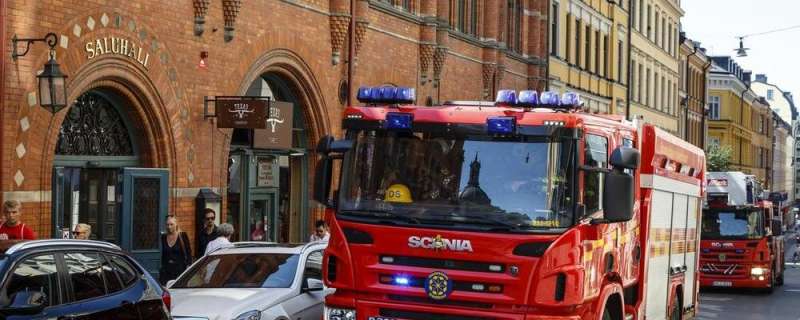The consequences of gender-coding of place and occupation in collaboration processes

In Europe, one-third of cities are affected by population decline, leading to financially demanding situations. How do municipalities ensure welfare and safety for citizens, at the same time as acting for more efficient use of municipal resources? A study analyzes a Swedish project for collaboration.
In an article in the European Journal of Women's Studies, Ulrika Jansson, Ph.D. in Working Life Science and researcher at the National Secretariat for Gender Research, University of Gothenburg, and Lena Grip, Ph.D. in Human Geography at Karlstad University, contribute to this field by analyzing a collaboration that has been introduced in a number of Swedish municipalities.
The collaborating partners in the project was the rescue service and the home-care service. The collaboration is intended to ensure welfare and safety for citizens, to guarantee a more efficient use of municipal resources, and to contribute to improved emergency management and civil protection. The research study was initiated by the Swedish Civil Contingencies Agency (MSB), with the aim to look into gendered obstacles and possibilities of collaboration between the rescue service and home-care service.
Collaboration as a 'universal solution'
"Even if collaboration is often delivered as a 'universal solution' for efficient use of resources, research shows that these processes are not always as easy as they sometimes seem in a project plan. A well-functioning collaboration can have great advantages, but the pain required to get there needs to be worth it. The processes are often difficult and complicated to implement in an efficient and satisfactory way" says Ulrika Jansson.
Organizations need to be willing to change their ingrained and traditional working methods and forms of organization, in order to try new methods, forms of collaboration. Just like other implementation processes of organizational change, successful collaboration processes require good communication, clear distribution of tasks and responsibilities, a clear idea of the common goal and balanced power relations between the parties involved.
Gender, place and work
The fact that work is gender-coded is well-established in research. Different occupations, positions and work tasks are gendered and marked, assumed to be more or less suited for a certain gender. The labor market is likewise a part of creating and recreating gendered identities. In other words, the labor market is formed by perceptions of gender-specific 'suitable' tasks, but it is also a part of forming identities.
Also within organizations notions on whether or not women or men are suited for a certain occupation or work tasks create segregation. By studying the structure and culture of an organization, conceptions of and presumptions about men's and women's positions and relations.
To these well-established ideas, the article brings understandings of organizational place. However, these studies often lack a thorough gender perspective. Ulrika Jansson and Lena Grip therefore argue that more research is needed, which combines the three perspectives of gender, place and work.
Places of co-operation
The rescue service and the home-care service are two clearly gender-coded occupations that also operate on gender-coded workplaces and places of work. The empirical data of the study is presented and analyzed from four identified places: The fire station, the car, the scene of the accident and the home. All these four places are clearly gender-coded and are also important places for the collaboration process. The fire station is, for example, an obvious example of a gender-coded place that is filled with meaning even before the collaboration begins:
"The nursing staff experience a higher status when they are based at the fire station. The also get access to a free gym at the workplace, and well-functioning buildings as their 'base'" says Ulrika Jansson.
Co-localisation at the fire station does not mean that the two groups automatically interact, as was intended. Practically, the boundaries are often actively upheld at the fire station to separate the two categories of staff. This is done both spatially and through interaction.
The home—the private place in the classical divide between public and private places—is another example of a gender-coded place that is filled with meaning already before the collaboration begins. While the collaboration processes might lead to a higher status for the nursing staff, the rescue service staff fear that the reverse would apply to them: that their occupation would assume a lower status by taking on too much of the nursing role and/or being associated with work tasks which to a great extent are performed by women and in private homes.
In the article Ulrika Jansson and Lena Grip analyze the gender-coding, the obstacles and possibilities of all the four important places of collaboration.
Gender coding work for effective collaboration
The results show that collaboration processes between municipal services are complex and challenge ideals of the organization, content and responsibility of work as well as who should perform certain work tasks. In the analyzed cooperation it is the main structure and culture of the rescue service that is challenged, since it has the superior position and the preferential right of interpretation in the collaboration.
The focus on the gender-coding of place and work highlights and problematizes the cooperating parties' organizational cultures and structures. Previous research show that it is important to even out the power relations between the parties involved in a collaboration process, in order to achieve sustainable collaboration. By the time of the study, this had not been addressed in the collaboration processes.
"Notions of gender and gender differences are reproduced and create obstacles through the collaboration. In the long term it affects the efforts of municipalities to ensure welfare and safety for citizens. Therefore we stress the importance of analyzing structural preconditions, what obstacles might occur and having a plan to handle them—before the collaboration begins." summarizes Ulrika Jansson.
More information: Lena Grip et al, 'The right man in the right place'—the consequences of gender-coding of place and occupation in collaboration processes, European Journal of Women's Studies (2021). DOI: 10.1177/13505068211042725
Provided by University of Gothenburg





















